Articles
- Page Path
- HOME > Korean J Community Nutr > Volume 16(4); 2011 > Article
-
Original Article
- Major Sources of Sodium Intake of the Korean Population at Prepared Dish Level: Based on the KNHANES 2008 & 2009
- Miyong Yon, Yoonna Lee, Dohee Kim, Jeeyeon Lee, Eunmi Koh, Eunjeong Nam, Hyehyung Shin, Baeg-won Kang, Jong Wook Kim, Seok Heo, Hea-young Cho, Cho-il Kim
-
Korean Journal of Community Nutrition 2011;16(4):473-487.
DOI: https://doi.org/10.5720/kjcn.2011.16.4.473
Published online: August 31, 2011
Nutrition Policy & Promotion Team, Korea Health Industry Development Institute, Chungbuk, Korea.
1Division of Nutrition Policy, Korea Food & Drug Administration, Chungbuk, Korea.
- Corresponding author: Cho-il Kim, Department of Food & Nutrition Industry, Korea Health Industry Development Institute, Osong Health Technology Administration Complex, 187 Osongseangmyeong2-ro, Gangoe-myeon, Cheongwon-gun, Chungbuk 363-700, Korea. Tel: (043) 713-8611, Fax: (043) 713-8907, kimci@khidi.or.kr
Copyright © 2011 The Korean Society of Community Nutrition
- 561 Views
- 1 Download
- 69 Crossref
Abstract
- We attempted to define the sources of sodium intake for the Korean population at prepared dish level to provide a basis for developing sustainable nutrition policies and feasible programs for sodium intake reduction. Dietary intake data from 2008 and 2009 Korea National Health and Nutrition Examination Survey was used in the analysis for sodium intake sources. Sodium intake from individual dish consumed by each subject was calculated and used in delineating major sodium sources at dish and dish group level for sub-populations of different sex and age. Also, sodium intake was compared between eaters and non-eaters of some specific dish groups with considerable contribution to total sodium intake. The number of subjects included in the analysis was 18,022 and mean sodium intake was 4,600 mg/capita/day. Major sources of sodium intake at dish group level were in the following order: kimchi (1125 mg, 24.5%), noodles (572 mg, 12.4%), soups (488 mg, 10.6%), stews (399 mg, 8.7%), and cooked rice (284 mg, 6.2%). The magnitude of contribution to total sodium intake by soups and stews was different by age group. Sodium intake difference between eaters and non-eaters was much larger for kimchi group (2,343 mg for male, 1,452 mg for female) than for soups or stews. Interaction between consumption of aforementioned specific dish groups and age was highly significant (p < 0.0005) for both sexes. This study revealed an importance of having not only the control over sodium content of foods/dishes, but also the customized approach for different groups of population to accomplish an appreciable reduction in sodium intake.
- 1. Alderman MH, Cohen H, Madhavan S. Dietary sodium intake and mortality: The National Health and Nutrition Examination Survey (NHANES I). Lancet. 1998; 351(9105): 781-785.ArticlePubMed
- 2. Blaustein MP, Hamlyn JM. Pathogenesis of essential hypertension. A link between dietary salt and high blood pressure. Hypertension. 1991; 18: 5 Suppl. III184-III195.ArticlePubMed
- 3. Brown IJ, Tzoulaki I, Candeias V, Elliott P. Salt intakes around the world: implications for public health. Int J Epidemiol. 2009; 38(3): 791-813.ArticlePubMed
- 4. Cho HS, Ahn MS. A survey on the consumption patterns of ramyon by high school students in a part Chun-nam area. J Living Cult Res. 1993; 7(1): 43-55.
- 5. Chobanian AV, Hill M. National Heart, Lung, and Blood Institute Workshop on Sodium and Blood Pressure: a critical review of current scientific evidence. Hypertension. 2000; 35(4): 858-863.ArticlePubMed
- 6. Cohen HW, Hailpern SM, Alderman MH. Sodium intake and mortality follow-up in the third National Health and Nutrition Examination Survey (NHANES III). J Gen Intern Med. 2008; 23(9): 1297-1302.ArticlePubMedPMCPDF
- 7. Craddick SR, Elmer PJ, Obarzanek E, Vollmer WM, Svetkey LP, Swain MC. The DASH diet and blood pressure. Curr Atheroscler Rep. 2003; 5: 484-491.ArticlePubMedPDF
- 8. Elliott P, Stamler J, Nichols R, Dyer AR, Stamler R, Kesteloot H, Marmot M. Intersalt Cooperative Research Group. Intersalt revisited: further analyses of 24 hour sodium excretion and blood pressure within and across populations. BMJ. 1996; 312(7041): 1249-1253.ArticlePubMedPMC
- 9. He J, Oqden LG, Vupputuri S, Bazzano LA, Loria C, Whelton PK. Dietary sodium intake and subsequent risk of cardiovascular disease in overweight adults. JAMA. 1999; 282(21): 2027-2034.ArticlePubMed
- 10. Hyun YH, Kim MH, Jang MS. Consumption patterns of ramyon by high school students. Korean J Soc Food Sci. 1990; 6(1): 61-66.
- 11. Intersalt Cooperative Research Group. Intersalt: an international study of electrolyte excretion and blood pressure. Results for 24 hour urinary sodium and potassium excretion. BMJ. 1988; 297(6644): 319-328.ArticlePubMedPMC
- 12. Jang MS, Hwang JH, Huun YH. Consumption pattern of ramyon by elementary school pupils. Korean J Soc Food Sci. 1988; 4(2): 81-86.
- 13. Kim SH, Abbasi F, Lamendola C, Reaven GM. Effect of moderate alcoholic beverage consumption on insulin sensitivity in insulin-resistant, nondiabetic individuals. Metabolism. 2009; 58(3): 387-392.ArticlePubMedPMC
- 14. Lee JS, Kim JS, Hong KH, Jang YA, Park SH, Sohn YA, Chung HR. A comparison of food and nutrient intakes between instant noodle consumers and non-consumers among Korean children and adolescents. Korean J Nutr. 2009; 42(8): 723-731.Article
- 15. Lee JW, Lee YH. Frequency of instant noodle(Ramyeon) intake and food value recognition and their relationship to blood lipid levels of male adolescents in rural area. Korean J Community Nutr. 2003; 8(4): 485-494.
- 16. Lee JY, Mok CK. Changes in physicochemical properties of low salt soybean paste(Doenjang) during fermentation. Food Eng Prog. 2010; 14(2): 153-158.ArticlePDF
- 17. Lee KW, Lee HS, Lee MJ. A study on the eating behaviors of self-purchasing snack among elementary school students. Korean J Food Cult. 2005; 20(5): 594-602.
- 18. Ministry of Health and Welfare, Korea Centers for Disease Control & Prevention. National Health Statistics - The 4th Korea National Health & Nutrition Examination Survey (KNHANES IV) 2009. 2010.
- 19. Ministry of Health and Welfare, Korea Centers for Disease Control & Prevention. National Health Statistics - The 4th Korea National Health & Nutrition Examination Survey (KNHANES IV) 2008. 2009.
- 20. Ministry of Health and Welfare, Korea Health Industry Development Institute. Database Development for Nutrient Composition of Foods. 2000.
- 21. Ministry of Health and Welfare, Korea Health Industry Development Institute. The Third Korea National Health & Nutrition Examination Survey (KNHANES III), 2005 - Nutrition Survey(I, II). 2006.
- 22. Mok CK, Song KT, Lee JY, Park YS, Lim SB. Changes in microorganisms and enzyme activity of low salt soybean paste (Doenjang) during fermentation. Food Engineering Progress. 2005; 14(2): 153-158.ArticlePDF
- 23. Moon HK, Choi SO, Kim JE. Analysis of nutrition education about sodium intakes for the elderly living in the rural area. Korean J Community Nutr. 2009; 14(1): 123-136.
- 24. Paik HY. Effect of salt intake and other dietary factors on development and treatment of hypertension in Korea. 2004; Ministry of Health & welfare.
- 25. Park SH, Lee JS, Hong H. The food and nutrient intakes on weekdays and weekends among high school girls in Seoul. Korean J Nutr. 2010; 43(5): 513-523.Article
- 26. Park YW, Zhu S, Palaniappan L, Heshka S, Carnethon MR, Heymsfield SB. The metabolic syndrome: prevalence and associated risk factor findings in the US population from the third National Health and Nutrition Examination Survey, 1988-1994. Arch Intern Med. 2003; 163(4): 427-436.ArticlePubMedPMC
- 27. Rhee M-Y, Yang SJ, Oh SW, Park Y, Kim C-i, Park H-K, Park SW, Park C-Y. Novel genetic variations associated with salt sensitivity in the Korean population. Hypertension Research. 2011; 34: 606-611.ArticlePubMedPDF
- 28. SAS Publishing. SAS/Stat 9.2 User Guide/Survey data analysis. Chapter 2. 2009; 13-24.
- 29. Son SM. Pilot study for low salt consumption projects for Korean people. 2009; Ministry of Health & Welfare.
- 30. Son SM, Park YS, Lim HJ, Kim SB, Jeong YS. Sodium intakes of Korean adults with 24-hour urine analysis and dish frequency questionnaire and comparison of sodium intakes according to the regional area and dish group. Korean J Community Nutr. 2007; 12(5): 545-558.
- 31. Stamler R. Implications of the intersalt study. Hypertension. 1991; 17: 1 Suppl. I16-I20.ArticlePubMed
- 32. Stamler J. The INTERSALT Study: background, methods, findings, and implications. Am J Clin Nutr. 1997; 65: 2 Suppl. 626S-642S.ArticlePubMed
- 33. Sung SH, Yu OK, Sohn HS, Cha YS. A comparison of dietary behaviors according to gender and obesity status of middle school students in Jeonju. J Korean Soc Food Sci Nutr. 2007; 36(8): 995-1009.Article
- 34. The Korean Nutrition Society. Dietary reference intakes for Koreans. 2010.
- 35. Tsugane S. Salt, salted food intake, and risk of gastric cancer: epidemiologic evidence. Cancer Sci. 2005; 96(1): 1-6.ArticlePubMedPMC
- 36. U.S. Department of Agriculture. Nutrient Intakes from Foods What We Eat in America, NHANES, 2007-2008. Agricultural Research Service. 2010. 2010; Available from http://www.ars.usda.gov/ba/bhnre/fsrg.
- 37. Xie JX, Sasaki S, Joossens JV, Kesteloot H. The relationship between urinary cations obtained from the INTERSALT study and cerebrovascular mortality. J Hum Hypertens. 1992; 6(1): 17-21.PubMed
- 38. Yang Q, Liu T, Kuklina EV, Flanders WD, Hong Y, Gillespie C, Chang MH, Gwinn M, Dowling N, Khoury MJ, Hu FB. Sodium and potassium intake and mortality among US adults: Prospective data from the third National Health and Nutrition Examination Survey. Arch Intern Med. 2011; 171(13): 1183-1191.ArticlePubMed
- 39. Yon MY, Lee MS, Oh SI, Park SC, Kwak CS. Assessment of food consumption, dietary diversity and dietary pattern during the summer in middle aged adults and older adults living in Gugoksoondam longevity area, Korea. Korean J Community Nutr. 2010; 15(4): 536-549.
REFERENCES
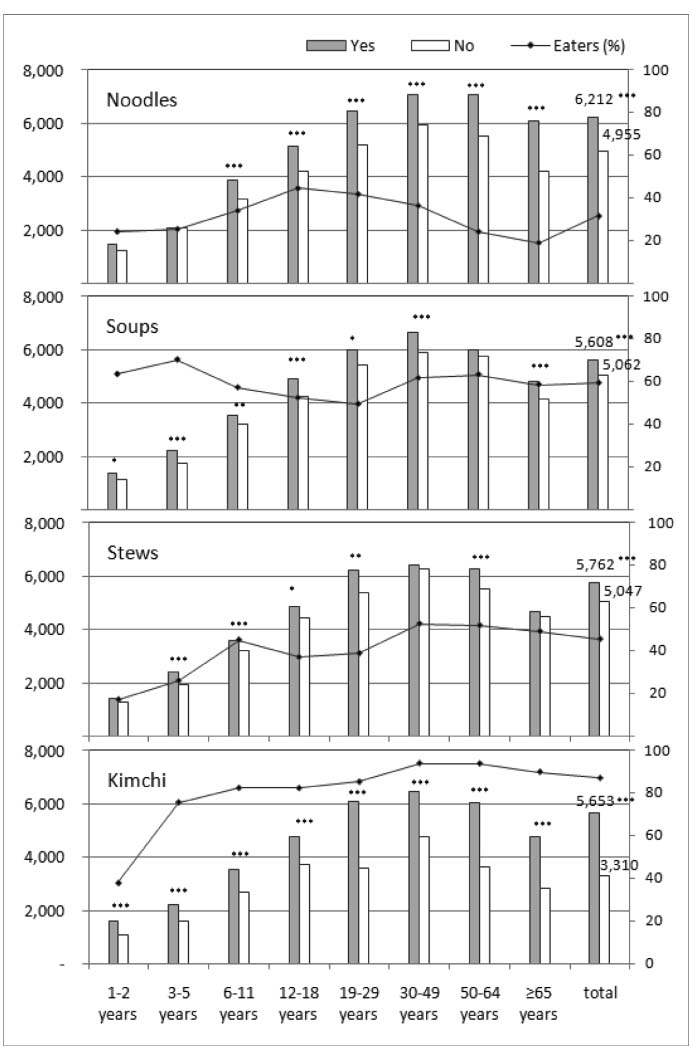
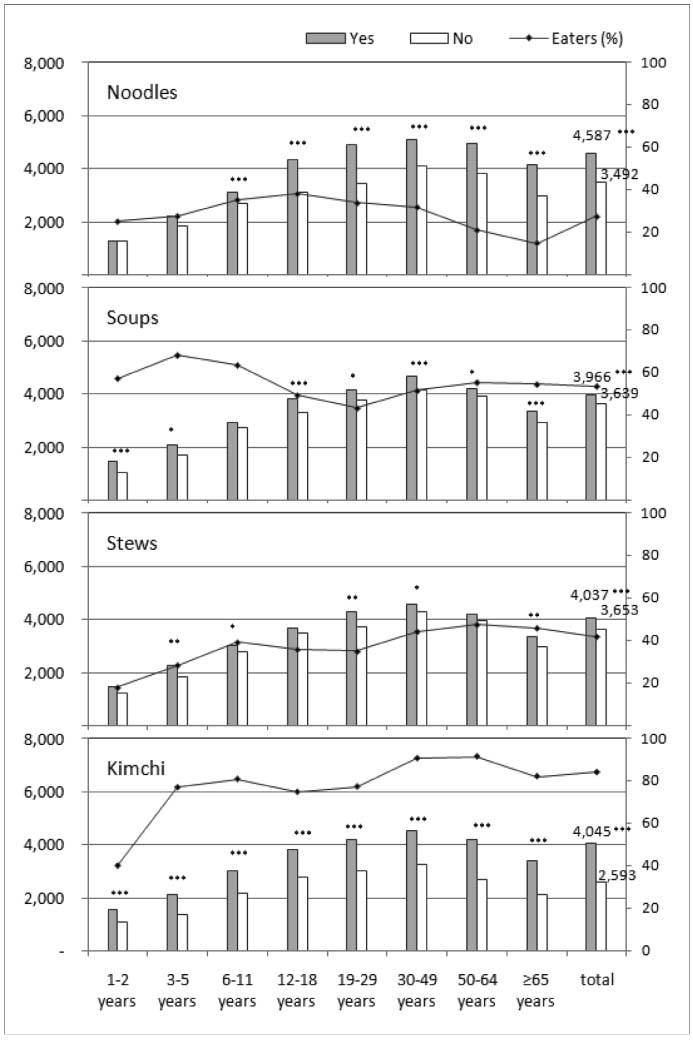
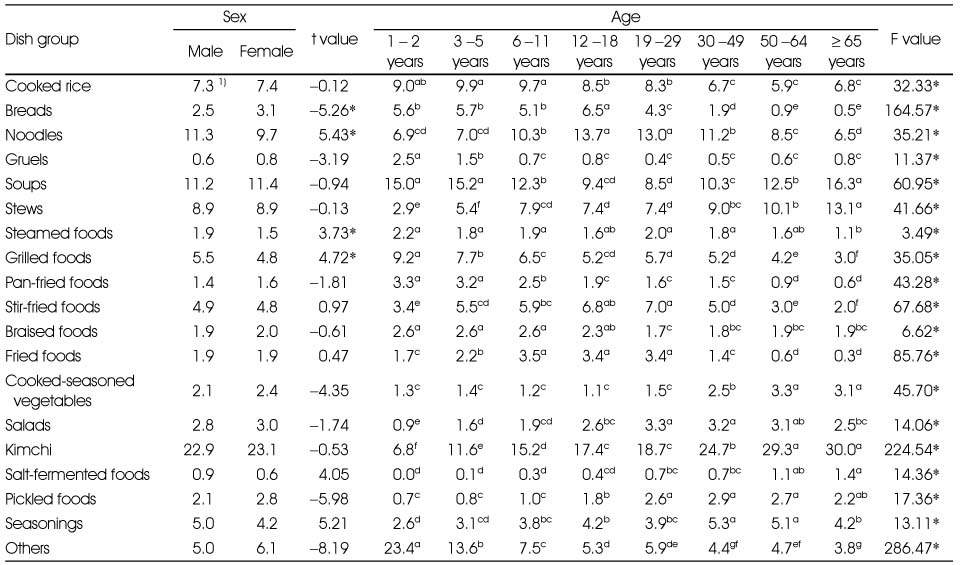
Figure & Data
REFERENCES
Citations

- A traditional Korean fermented food, Gochujang exerts anti-hypertensive effects, regardless of its high salt content by regulating renin-angiotensin-aldosterone system in SD rats
Jung Eun Park, Anna Han, Eun-Gyung Mun, Youn-Soo Cha
Heliyon.2024; 10(9): e30451. CrossRef - Health-related quality of life and nutrient intake of the elderly with type 2 diabetes according to comorbidity burden: a cross-sectional study
Yejung Choi, Kyong Park
Korean Journal of Community Nutrition.2024; 29(5): 418. CrossRef - Exposure to Extreme Temperatures and Change in Dietary Patterns in Korea
Seungyeon Cho
Atmosphere.2024; 15(12): 1477. CrossRef - Comparison between 24-hour diet recall and 24-hour urine collection for estimating sodium and potassium intakes and their ratio among Korean adults
Taisun Hyun, Mi-Kyeong Choi, Young-Ran Heo, Heekyong Ro, Young-Hee Han, Yeon-Kyung Lee
Nutrition Research and Practice.2023; 17(2): 284. CrossRef - Evaluation of diet quality according to the eating-out patterns of preschoolers and school-aged children in South Korea: based on data from the 2016–2018 Korea National Health and Nutrition Examination Survey
Yu-na Ju, Youngmi Lee, Kyunghee Song, Yujin Lee
Journal of Nutrition and Health.2021; 54(2): 165. CrossRef - Status of serving labeling of home meal replacement-soups and stews, and evaluation of their energy and nutrient content per serving
Mi-Hyun Kim, In-Young Choi, Jee-Young Yeon
Journal of Nutrition and Health.2021; 54(5): 560. CrossRef - Trends in sodium intake and major contributing food groups and dishes in Korea: the Korea National Health and Nutrition Examination Survey 2013–2017
Yeseung Jeong, Eui Su Kim, Jounghee Lee, Yuri Kim
Nutrition Research and Practice.2021; 15(3): 382. CrossRef - Gastric Cancer and the Daily Intake of the Major Dish Groups Contributing to Sodium Intake: A Case-Control Study in Korea
Jung-Hyun Kwak, Chang-Soo Eun, Dong-Soo Han, Yong-Sung Kim, Kyu-Sang Song, Bo-Youl Choi, Hyun-Ja Kim
Nutrients.2021; 13(4): 1365. CrossRef - EOSINOPHIL CATIONIC PROTEIN AND IRON STATUS IN PATIENTS INFECTED WITH Enterobius vermicularis
Esraa Wathah, Saleem Khteer Al-Hadraawy
Journal of Experimental Biology and Agricultural Sciences.2021; 9(5): 672. CrossRef - Progress on sodium reduction in South Korea
Hye-Kyung Park, Yoonna Lee, Baeg-Won Kang, Kwang-il Kwon, Jong-Wook Kim, Oh-Sang Kwon, Laura K Cobb, Norman R C Campbell, Drew E Blakeman, Cho-il Kim
BMJ Global Health.2020; 5(5): e002028. CrossRef - Comparison of Salinity and Sodium Content by the Salinity Measurement Frequency of Soups of Childcare Centers Enrolled in the Center for Children's Food Service Management in Daegu
Na-Yeong Lee, Yeon-Kyung Lee
Korean Journal of Community Nutrition.2020; 25(1): 13. CrossRef - Effect of nutrition education in reducing sodium intake and increasing potassium intake in hypertensive adults
You-Sin Lee, Moo-Yong Rhee, Sim-Yeol Lee
Nutrition Research and Practice.2020; 14(5): 540. CrossRef - Comparison of the sodium content of Korean soup-based dishes prepared at home, restaurants, and schools in Seoul
Yanghee Park, Jihyun Yoon, Sang-Jin Chung
Journal of Nutrition and Health.2020; 53(6): 663. CrossRef - Nineteen-year trends in fermented food consumption and sodium intake from fermented foods for Korean adults from 1998 to 2016
Sang Young Kim, Jeanne H Freeland-Graves, Hyun Ja Kim
Public Health Nutrition.2020; 23(3): 515. CrossRef - Customers' Perceptions of Operational Status of and Needs for Sodium Reduction in the Industry Foodservice in Seoul
Na-Young Yi
Korean Journal of Community Nutrition.2020; 25(1): 21. CrossRef - Changes in the Quality of Life in Patients with Type 2 Diabetes Mellitus According to Physician and Patient Behaviors
Young-Joo Kim, In-Kyung Jeong, Sin-Gon Kim, Dong Hyeok Cho, Chong-Hwa Kim, Chul-Sik Kim, Won-Young Lee, Kyu-Chang Won, Jin-Hye Cha, Juneyoung Lee, Doo-Man Kim
Diabetes & Metabolism Journal.2020; 44(1): 91. CrossRef - Periodic Revisions of the International Choices Criteria: Process and Results
Sylvie van den Assum, Rutger Schilpzand, Lauren Lissner, Rokiah Don, Krishnapillai Madhavan Nair, Ngozi Nnam, Ricardo Uauy, Yuexin Yang, Ayla Gulden Pekcan, Annet J. C. Roodenburg
Nutrients.2020; 12(9): 2774. CrossRef - Validity of Estimating Sodium Intake using a Mobile Phone Application of 24-hour Dietary Recall with Meal Photos
Seo-Yoon Kim, Sang-Jin Chung
Korean Journal of Community Nutrition.2020; 25(4): 317. CrossRef - Health-related quality of life in elderly patients with diabetes mellitus according to age: based on Korea National Health and Nutrition Examination Survey
Yeji Kang, Kyong Park
Journal of Nutrition and Health.2020; 53(2): 129. CrossRef - Food Sources of Sodium in Korean Americans With Type 2 Diabetes: Implications for Cardiovascular Disease
Jisook Ko, Gayle M. Timmerman, Kim B. Kim, Miyong T. Kim
Journal of Transcultural Nursing.2019; 30(2): 154. CrossRef - Risk of Metabolic Syndrome among Middle-Aged Koreans from Rural and Urban Areas
Seohyun Lee, Yoonjin Shin, Yangha Kim
Nutrients.2018; 10(7): 859. CrossRef - Risk of Metabolic Syndrome according to Intake of White Rice and Kimchi in Korean Adults: based on the 6th Korea National Health and Nutrition Examination Survey, 2013–2015
Jin-Su Kim, So Hyun Ahn, Sook Mee Son
Korean Journal of Community Nutrition.2018; 23(6): 525. CrossRef - Effect of a public health center-based nutrition education program for hypertension in women older than 50 years of age
Seoyun Park, Jong-Sook Kwon, Hye-Kyeong Kim
Journal of Nutrition and Health.2018; 51(3): 228. CrossRef - Analysis of Sodium Content and Tastes of Ramyeon Cooked Using Different Recipes
Chang-Hwan Oh, Chung Ha-Yull
Korean Journal of Food and Cookery Science.2018; 34(5): 450. CrossRef - Impacts of High Sodium Intake on Obesity-related Gene Expression
Minjee Lee, Miyoung Park, Juhee Kim, Soyoung Sung, Myoungsook Lee
Journal of the East Asian Society of Dietary Life.2018; 28(5): 364. CrossRef - Low Estimated Glomerular Filtration Rate Is Prevalent among North Korean Refugees in South Korea
Young-Soo Song, Seong-Woo Choi
Korean Journal of Family Medicine.2018; 39(3): 161. CrossRef - Nutritional Evaluation of Convenience Meals in Convenience Stores near the Universities
Go-Na Shin, Yu-Ri Kim, Mi-Hyun Kim
Korean Journal of Community Nutrition.2017; 22(5): 375. CrossRef - Stages of Behavioral Change for Reducing Sodium Intake in Korean Consumers: Comparison of Characteristics Based on Social Cognitive Theory
So-hyun Ahn, Jong Kwon, Kyungmin Kim, Hye-Kyeong Kim
Nutrients.2017; 9(8): 808. CrossRef - Study of the characteristics of dietary behavior and the effects of nutrition education for sodium reduction according to the stages of behavioral change in sodium reduction of male adult subjects in Gwangju·Jeonnam regions
Young Ran Heo, Hyun Young Oh, Hee Kyong Ro
Journal of Nutrition and Health.2017; 50(5): 472. CrossRef - Status of Recognition, Effort, and Satisfaction of Customers on Low-Sodium Diet in Industry Foodservice
Sang Jin Yoon, Kun Og Kang
Journal of the East Asian Society of Dietary Life.2017; 27(2): 168. CrossRef - Dietary assessment according to intake of Korean soup and stew in Korean adults: Based on the 2011~2014 Korea National Health and Nutrition Examination Survey
Yong-Suk Kwon, Gyusang Han
Journal of Nutrition and Health.2016; 49(5): 335. CrossRef - Major Dishes Contributing Absolute and Between-Person Sodium Intake Variations in University Students in Gyeonggi-do
Eun-Jung Chung, Ha-Jung Ryu, Eugene Shim
Journal of the Korean Society of Food Science and Nutrition.2016; 45(3): 409. CrossRef - Dietary quality differs by consumption of meals prepared at home vs. outside in Korean adults
Kyung Won Lee, Won O. Song, Mi Sook Cho
Nutrition Research and Practice.2016; 10(3): 294. CrossRef - Association Between Estimated 24-h Urinary Sodium Excretion and Metabolic Syndrome in Korean Adults
Jong Chul Won, Jae Won Hong, Jung Hyun Noh, Dong-Jun Kim
Medicine.2016; 95(15): e3153. CrossRef - Changes in Adherence to Non-Pharmacological Guidelines for Hypertension
Kyong Park, Sukyung Cho, Julie K. Bower, Yan Li
PLOS ONE.2016; 11(8): e0161712. CrossRef - Quality and sensory characteristics of commercial kimchi according to sodium contents
Eun-Sun Hwang, Hyo Sung Kim, Soo Hyun Kim, Hyun Joo Ko, Mi Young Lee, Eun-Kyung Yoon
Korean Journal of Food Science and Technology.2016; 48(5): 413. CrossRef - A Comparison of Sources of Sodium and Potassium Intake by Gender, Age and Regions in Koreans: Korea National Health and Nutrition Examination Survey (KNHANES) 2010-2012
Yang-hee Park, Sang-Jin Chung
Korean Journal of Community Nutrition.2016; 21(6): 558. CrossRef - Verification of Utility of Simple Mensuration of Cl-from Urine to Estimate the Amount of Sodium Intake
Sung-Ho Lee, Chae-Joon Lee, Sung-Mi Ju, Hyun-Joo Lee, Wang-Yeon Ra, Soon-Ok Kim
The Korean Journal of Food And Nutrition.2016; 29(1): 27. CrossRef - Major Foods and Nutrient Intake Quality According to Body Image Perception among Korean Women: Based on the 2010 Korea National Health and Nutrition Examination Survey Data
Young Suk Lim, Soo Bin Jeon, Hee Mang Kim, So Yeon Jeong, Jae Young Ahn, Hae Ryun Park
Journal of the Korean Dietetic Association.2015; 21(2): 154. CrossRef - A Study on the Kimchi Consumption of Korean Adults:Using Korea National Health and Nutrition Examination Survey (2010~2012)
Eun-Kyung Kim, Yoo-Kyung Park, Se-Young Ju, Eun-Ok Choi
Journal of The Korean Society of Food Culture.2015; 30(4): 406. CrossRef - Nutrition knowledge, eating attitudes, nutrition behavior, self-efficacy of childcare center foodservice employees by stages of behavioral change in reducing sodium intake
Yun Ahn, Kyung Won Kim, Kyungmin Kim, Jinwon Pyun, Ikhyun Yeo, Kisun Nam
Journal of Nutrition and Health.2015; 48(5): 429. CrossRef - Parathyroid Hormone, Calcium, and Sodium Bridging Between Osteoporosis and Hypertension in Postmenopausal Korean Women
Jee Soo Park, Soo Beom Choi, Yumie Rhee, Jai Won Chung, Eui-Young Choi, Deok Won Kim
Calcified Tissue International.2015; 96(5): 417. CrossRef - Evaluation of Consumer Nutrition Education Program to Reduce Sodium Intake Based on Social Cognitive Theory
So-Hyun Ahn, Jong Sook Kwon, Kyung Min Kim, Jin-Sook Yoon, Hye-Kyeong Kim
Korean Journal of Community Nutrition.2015; 20(6): 433. CrossRef - A Study on Sodium-related Dietary Attitude and Behaviors According to Sodium-related Nutrition Knowledge of University Students
Mi-Hyun Kim, Jee-Young Yeon, Jong Wook Kim, Jae-Eon Byun, So-Young Bu, Mi-Kyeong Choi, Yun-Jung Bae
Korean Journal of Community Nutrition.2015; 20(5): 327. CrossRef - A Study on Eating Out Behavior and Recognition of Salinity in Restaurant Food in Jecheon Area
Soojin Park, Sung Hee Min
Journal of The Korean Society of Food Culture.2015; 30(1): 20. CrossRef - Contents of Sodium and Potassium for Restaurant Dishes in Seoul
Mi-ra Jang, Mi-sun Hong, Bu-chuhl Choi, Sung-hee Han, Kyeong-ah Lee, Li-la Kim, Jib-ho Lee, Jung-hun Kim, Kweon Jung
Journal of Food Hygiene and Safety.2015; 30(2): 189. CrossRef - The Relationship between Daily Sodium Intake and Obesity in Korean Adults
Jung-hoon Kim, Gyeong Eun Lim, Sunyoung Kang, Kayoung Lee, Tae-jin Park, Jinseung Kim
Korean Journal of Health Promotion.2015; 15(4): 175. CrossRef - Quality Characteristics of Low-sodium Tomato Jangajii according to Storage Time by Cultivars
Yeon Sook Park, Hae Jeong Gweon, Ki Hyeon Sim
Journal of the East Asian Society of Dietary Life.2015; 25(3): 460. CrossRef - Evaluation of Obesity and Nutritional Status by Age among Low-income Women aged over 20 -Using Data from the Fourth Korea National Health and Nutrition Examination Survey-
Hee-Kyung Jang
Journal of the East Asian Society of Dietary Life.2015; 25(2): 246. CrossRef - Survey on Nutrition Knowledge, Food Behaviors, and Food Frequency of Sodium Intake in Korean University Students
Hee-Ok Pak
Journal of the East Asian Society of Dietary Life.2015; 25(1): 12. CrossRef - Preparation of Sun-dried Salt Containing GABA by Co-crystallization of Fermentation Broth and Deep Sea Water
Bu-Young Choi, Seok-Cheol Cho
Food Engineering Progress.2015; 19(4): 420. CrossRef - Study on Sodium Reduction: 'Healthy Restaurant for Sodium Reduction'
Soon Myung Hong, Jee Hye Lee, Hye-Kyung Kim, Rina Yu, Jeong Hee Seo, Eun Jeong Huh, Seong Suk Cho, Jeongah Yang
Journal of the Korean Dietetic Association.2014; 20(3): 174. CrossRef - Salt-related Dietary Behaviors of University Students in Gyeongbuk Area
Kyung-A Lee
Journal of the Korean Society of Food Science and Nutrition.2014; 43(7): 1122. CrossRef - Blood Pressure and Dietary Related Risk Factors Associated with High Sodium Intake Assessed with 24-hour Urine Analysis for Korean Adults
Yeon-Seon Jeong, Hwa-Jae Lim, Sook-Bae Kim, Hee Jun Kim, Sook Mee Son
Korean Journal of Community Nutrition.2014; 19(6): 537. CrossRef - Comparison of sodium content of workplace and homemade meals through chemical analysis and salinity measurements
Eun-Kyung Shin, Yeon-Kyung Lee
Nutrition Research and Practice.2014; 8(5): 558. CrossRef - Effects of short-term supplementation of erythritol-salt on urinary electrolyte excretion in rats
Myungok Kyung, Ji Ye Lim, Kyungsun Lee, Sangwon Jung, Keunbum Choe, Chang-kun Yang, Yuri Kim
Journal of Nutrition and Health.2014; 47(2): 99. CrossRef - An Evaluation of Dietary Habit and Nutritional Status by Household Income in Female Adults over the Age of 20 - Using Data from the Fourth Korea National Health and Nutrition Examination Survey -
Hee-Kyung Jang
The Korean Journal of Food And Nutrition.2014; 27(4): 660. CrossRef - A study of the major dish group, food group and meal contributing to sodium and nutrient intake in Jeju elementary and middle school students
Yang-Sook Ko, Hye-Yun Kang
Journal of Nutrition and Health.2014; 47(1): 51. CrossRef - Analysis of presumed sodium intake of office workers using 24-hour urine analysis and correlation matrix between variables
Hyun-Hee Kim, Yeon-Kyung Lee
Korean Journal of Nutrition.2013; 46(1): 26. CrossRef - Trends in the major dish groups and food groups contributing to sodium intake in the Korea National Health and Nutrition Examination Survey 1998-2010
Da Young Song, Jong Eun Park, Jae Eun Shim, Jung Eun Lee
Korean Journal of Nutrition.2013; 46(1): 72. CrossRef - Factors Associated with a Low-sodium Diet: The Fourth Korean National Health and Nutrition Examination Survey
Won Joon Lee, Hyeon Chang Kim, Sun Min Oh, Dong Phil Choi, Jaelim Cho, Il Suh
Epidemiology and Health.2013; 35: e2013005. CrossRef - Sodium density and obesity; the Korea National Health and Nutrition Examination Survey 2007–2010
Y S Yoon, S W Oh
European Journal of Clinical Nutrition.2013; 67(2): 141. CrossRef - Sodium Content and Nutrients Supply from Free Lunch Meals Served by Welfare Facilities for the Elderly in Gyeonggi-do
Seoyun Park, So Hyun Ahn, Jin Nam Kim, Hye-Kyeong Kim
The Korean Journal of Food And Nutrition.2013; 26(3): 459. CrossRef - Establishment of One Portion Size of Dishes Frequently Consumed by Korean Adults using 2010 KNHANES and Its Comparison with the One Portion Size using 2005 KNHANES - Focusing on Rice, Noodles, Soups, and Stews -
Sook-Bae Kim, Soon-Kyung Kim, Se-Na Kim, Young-Sook Cho, Mi-Hyun Kim
The Korean Journal of Food And Nutrition.2013; 26(4): 745. CrossRef - A Survey on the Salt Content of Kindergarten Lunch Meals and Meal Providers' Dietary Attitude to Sodium Intake in Gyeonggi-do Area
Jin Nam Kim, Seoyun Park, Sohyun Ahn, Hye-Kyeong Kim
Korean Journal of Community Nutrition.2013; 18(5): 478. CrossRef - Salt content of school meals and comparison of perception related to sodium intake in elementary, middle, and high schools
Sohyun Ahn, Seoyun Park, Jin Nam Kim, Sung Nim Han, Soo Bin Jeong, Hye-Kyeong Kim
Nutrition Research and Practice.2013; 7(1): 59. CrossRef - A Study on the Knowledge, Dietary Behavior related to Sodium, Attitudes towards a Low-Salt Diet of Adults in the Jeonbuk Area
Jeongok Rho, Hyuna Kim
Korean Journal of Human Ecology.2013; 22(4): 693. CrossRef - Study on the Eating Habits and Practicability of Guidelines for Reducing Sodium Intake according to the Stage of Change in Housewives
So-Hyun Ahn, Jong-Sook Kwon, Kyungmin Kim, Jin-Sook Yoon, Baeg-Won Kang, Jong wook Kim, Seok Heo, Hea-Young Cho, Hye-Kyeong Kim
Korean Journal of Community Nutrition.2012; 17(6): 724. CrossRef - Salt Intake and Diabetes
Jeong Hyun Lim
The Journal of Korean Diabetes.2012; 13(4): 211. CrossRef
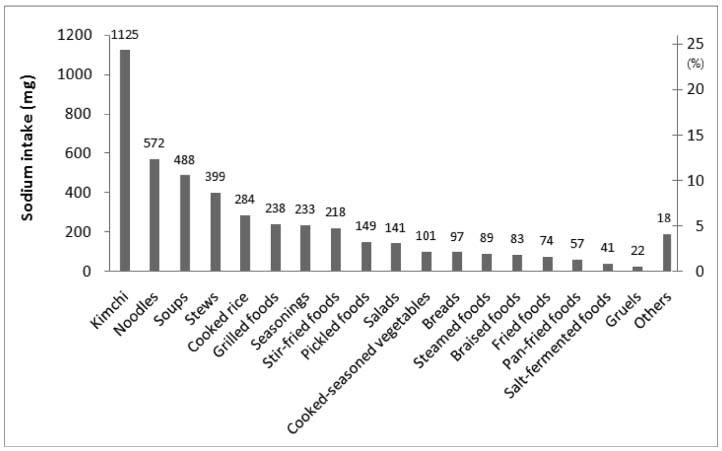
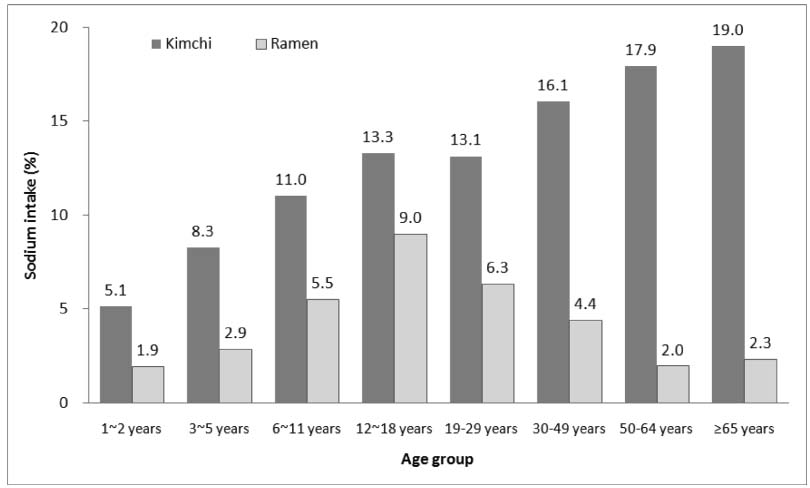


Fig. 1
Fig. 2
Fig. 3
Fig. 4
Distribution of subjects by gender and age
1) N (Proportion in %)
Mean sodium intake of subjects by gender and age
*: p < 0.0001
Comparison of sodium intake contribution from individual dish group by sex and age of subjects
*: p < 0.0001
1) Sodium intake contribution of each dish group(%)
2) a, b, c: Mean with by different superscripts are significantly different by Duncan's multiple range test
Comparison of top 20 individual dishes contributing to total sodium intake of subjects by sex
1) Cumulative percentage
Comparison of top 20 individual dishes contributing to total sodium intake of subjects by age
1) Cumulative percentage
1) N (Proportion in %)
*: p < 0.0001
*: p < 0.0001 1) Sodium intake contribution of each dish group(%) 2) a, b, c: Mean with by different superscripts are significantly different by Duncan's multiple range test
1) Cumulative percentage
1) Cumulative percentage

 KSCN
KSCN


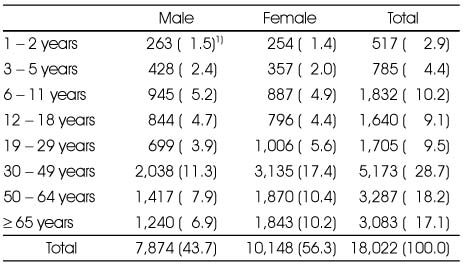

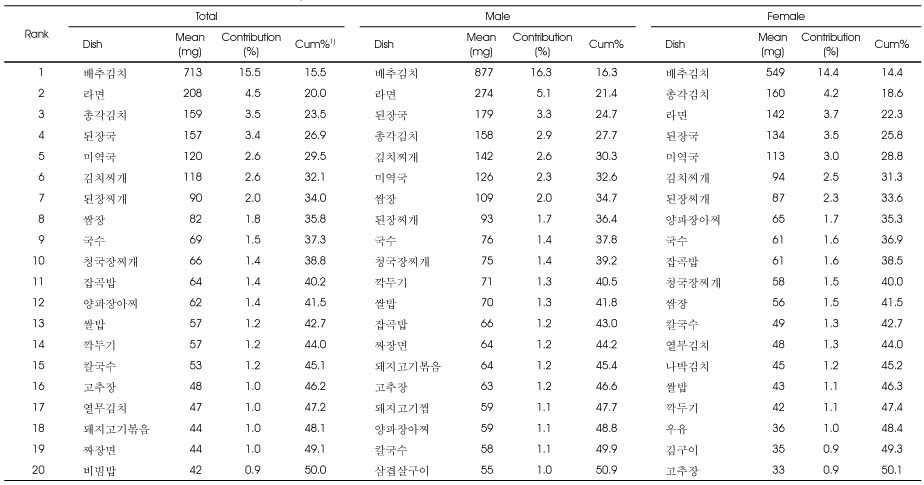
 PubReader
PubReader Cite
Cite


